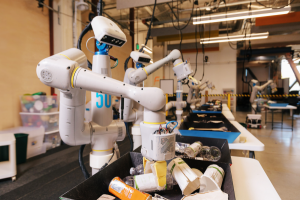Ivanka Trump took the stage at CES on Tuesday to muted reception. Forty minutes later, she left to robust applause. No surprise, maybe, given the uncontroversial theme: The US needs to prepare workers for the future. At a technology-focused show, that’s not exactly a hard sell. But a closer look at the Trump administration’s attitude toward work—and workers—belies her pitch and invites a question: Whose future is it we’re preparing for?
The Consumer Technology Association received loud, immediate criticism when the trade organization announced last month that it was hosting the president’s daughter as a keynote speaker at CES. Expecting a major corporate lobbying group to enlist in #TheResistance seems unrealistic, especially three years in. The tech industry at large benefits enormously from Trump’s tax cuts and has a vested interest in helping reach a trade war détente. Apple CEO Tim Cook, a vocal advocate of privacy and human rights, invited Trump père to an Apple plant just a few months ago and smiled placidly while the president lied his tail off. The CTA’s embrace of Trump is as surprising as a hot dog’s embrace of mustard.
And Ivanka does have a case for being on the CES stage. She spearheaded the administration’s Pledge to American Workers program, which has enlisted 400 companies to agree to provide job training to 14 million people. The White House signed off on a reauthorization of the Perkins Act, which allocated $1.2 billion for career technical education programs and has laid out a five-year plan to bolster STEM education. “Education and workforce policy has been one of the brightest spots of bipartisan cooperation over the past three years,” says Alex Burgos, vice president of federal policy, government relations and communications at TechNet, a tech company advocacy group that has previously criticized the administration’s sweeping immigration crackdown.
In a ballroom at the Venetian hotel in Las Vegas packed with tech executives and assorted media, Trump pointed to some of those accomplishments. “That’s really my foremost passion, removing barriers and obstacles for people who want to and can work to be able to provide for themselves and their families,” Trump said.
In isolation, it’s hard to disagree with much of what Trump suggests. STEM education? Yes, please. Train workers for the jobs of the future? Absolutely. Provide more money for child care to take the burden off of dual-income families? Check! But the future of work, and more importantly of workers, isn’t determined solely by the programs and policies that have those words in the header. It’s shaped by the totality of the administration’s policies. In that broader context?
“I think it’s unambiguously bad,” says Heidi Schierholz, an economist with the liberal Economic Policy Institute and Department of Labor staffer in the Obama administration. “Every single time there’s a juncture where they could protect corporate interests or the interests of workers, they protect corporate interests.”
That applies even to ostensibly pro-worker programs like the Pledge to American Workers. “What we know is, most of the federal government training programs don’t work. What does work is when the private sector teams with a community college, a technical school, a university, a high school, and develops a curriculum that is taught to students and then ultimately hires those students,” Trump said on Tuesday.
One problem: They often don’t, especially when the training comes from the corporate side. “The programs that we believe are the best and most effective are where labor and management come together and workers have a voice in the process. We jointly funded industry programs where workers have credentials, where workers learn a skill and get a real job,” says Liz Shuler, secretary-treasurer of the American Federation of Labor and Congress of Industrial Organizations. “You’ve seen the model deteriorate over time, where more of the burden is falling on the individual, and in a marketplace where they’re sponsored by for-profit entities that take their money and [they] end up with nothing at the end of it.”
It’s unsurprising that the AFL-CIO would take a pro-union position. But recent studies have also backed that claim; in 2017, the Midwest Economic Policy Institute found that apprentices in joint labor-management programs in Ohio were 21 percent more likely to complete their training. Similar results have been found in Kentucky and Great Britain, as noted by the Center for American Progress.
Besides which, the Pledge to American Workers is largely duplicative; Bloomberg found that many of the companies involved would have done the training anyway. More troubling, it lacks oversight and accountability, entrusting the private sector to train workers with their best interests in mind, without repercussions for failing to do so.
Take a closer look, too, at the $2 billion in additional funding for the Child Care and Development Block Grant that Trump touted Tuesday. The grant itself dates to an Obama-era reauthorization; the additional funds, appropriated by Congress, have been used to increase the number of children helped in only 16 states, according to a study from research group Child Trends.
And then step back a bit to assess the entire field of Trump administration policies. “They’re taking a ton of regulatory action, basically all of which leaves workers behind,” says Schierholz. Some of that is granular, like weakening overtime rules for hourly workers. Some if it is sweeping, like cuts to the social safety net. And some of it is systemic, like a dwindling Social Security pool. The future of work is inextricably tied to the future of workers, which the Trump administration has put very much in doubt.
“Working people are bearing the brunt of these policies,” says Shuler. “The Department of Labor has cut funding from safety and health inspectors. The Social Security system is in dire straits. Are we going to let that collapse? The so-called gig economy that people are touting as the future of the economy, how are they going to do that if they don’t have the safety net in place?”
Ivanka Trump has plenty to say about investing in American workers and providing paths to success that don’t require a four-year degree. She sounds earnest in her desire to make work-life balance more economically feasible for parents. And she sees tech and cybersecurity as industries ripe for labor force disruption.
“If we can’t come together on this, we can’t come together on anything,” she said as her session came to a close. Which is true enough, as long as you avoid looking at the details.
More From CES 2020
- Liveblog Day 2: Get the latest from Las Vegas
- Gallery: 10 more extraordinary gadgets we’ve spotted at CES
- The Inventors Hall of Fame honors pioneering brainiacs
- The new version of Bluetooth is here to fix your headphones
- Intel maps out a foldable, AI-infused PC future
- Lenovo flaunts its foldable PC, the ThinkPad X1 Fold
- Looking for more? Check out our full coverage here
- 📩 Sign up for the Gadget Lab newsletter for news and reviews you can use



